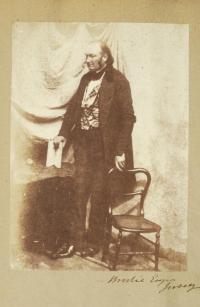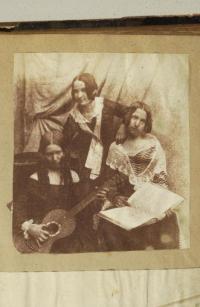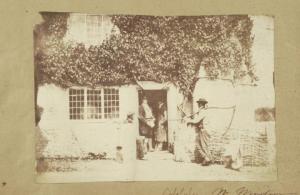The Graphic Arts division holds a scrapbook of early paper photography compiled by the British optician and amateur photographer, Richard Willats. After several years of work by many staff members, the entire scrapbook has been digitized and is available for public view at http://diglib.princeton.edu/
xquery?xq=getCollection&xsl=collection
&_pid=gc131willats
In the early 1840s, T. & R. Willats was one of the leading scientific instrument makers in London, specializing in barometers, thermometers, and telescopes. It was also one of only two companies supplying photographic chemistry and equipment to the amateur practitioners of the day. Opticians (and brothers?) Thomas and Richard Willats had shops at 98 Cheapside (1840s-50), 28 Ironmonger Lane (1851-56), and 2 Church Lane, Homerton (1857-60).

Sir John Herschel; Horne, Thornewaite, & Wood; John Johnston; Negretti & Zambra; Nicholson; T. S. Redman; J. Sherrington; G. Wharton Simpson; Thomas Sutton; William Harding Warner; Richard Willats; and Walter Bentley Woodbury.
These photographs include portraits, architectural scenes, and events of the day, such as the collapsed Fleet Street Sewer and of the destroyed Underground Railway Works. Geographic locations in these images include London, Paris, Holland, and Japan. One print, by an unidentified photographer, is captioned “The first photograph taken from a negative on glass.”
Many of these men were leading practitioners of early paper photography. Robert Bingham was the author of his own manuals including Photogenic Manipulation. Part I: Containing the Theory and Plain Instructions in the Art of Photography, or the Production of Pictures through the Agency of Light…. 4th ed. (London: George Knight and Sons, [1847]) and The Collodion Process: being a supplement to Part I of Photogenic Manipulation (London: G. Knight and Sons, [1852]).
Sir John Herschel was a scientist, chemist, and astronomer. Herschel discovered the chemistry for a fixing agent or “hypo”, and then in 1839, invented a photographic process using sensitized paper. Herschel coined the use of the terms “photography,” “positive,” and “negative.”
Joseph Cundall was a leading book binder and publisher, known for his handsome illustrated children’s books. He also experimented with early paper photography.
Opticians Henry Negretti and Joseph Warren Zambra formed a scientific instrument company, Negretti & Zambra, in 1850. They also printed and published photographs using various early processes.
The Willats album was first surveyed by William F. Stapp for his Catalogue of photographs … in the collections of the department of Rare Books and Special Collections, Princeton University Library and in the Princeton University Art Museum. Contents of the Willats album include:
Bingham, Robert J. (Jefferson) (British, 1825-1870), active Paris, 3 calotypes, architectural views, 1 colored by Richard Willats, ca. 1848
Brewster, Captain Henry (British, 1816-1905), 2 calotypes, self-portrait and portrait of a man, ca. 1845
Brodie (British, active 1840s), active Isle of Jersey, 21 calotypes, genre studies and portraits
Brodie, attributed to, (British, active 1840s) active Isle of Jersey, 43 calotypes, genre studies and portraits
Buckle, Samuel (British, 1808-1860), 8 calotypes, 1 architectural view, 7 copies of paintings and engravings
Cocke, Archibald Lewis (British, active 1847-50), 11 calotypes, architectural views
Cocke, Archibald Lewis (British, active 1847-50), 1 calotype negative, architectural view
Cocke, Archibald Lewis, attributed to, (British, active 1847-50), 14 calotypes, architectural views
Croucher, John H. (British, active 1840s), 5, energiatype negatives
Croucher, John (British, active 1840s), 1 energiatype negative
Croucher, John, attributed to, (British, active 1840s, 1 energiatype negative
Cundall, Joseph (British, 1818-1895), 1 calotype, “London from Blackfriars Bridge” 1844
Cundall, Joseph (British, 1818-1895), 1 calotype, “Quandrant, Regent Street” 1847
Field, [Robert] (British, active 1840s), active Birmingham, 2 calotypes, portraits of men, ca. 1845
Henry, Charles (British, active 1840s), 1 albumen silver print, portrait of two boys, ca. 1860
Herschel, Sir John (British, 1792-1871) 1 cyanotype, copy of an engraving
Horne, Thornewaite, and Wood, (British firm active 19th century), 1 salt print, portrait of Fallon Horne
Johnstone, John (British, active 1840s) active Birmingham, 2 calotypes, portrait of a man and double portrait of two girls, ca. 1850
Negretti, Henry (British, 1818-1879) and Joseph Zambra (British, 1822-188?), 3 albumen silver prints, views of the collapsed Fleet Street Sewer and of the destroyed Underground Railway Works, 1862
Nicholson, (British, active 1840s), active London, 4 calotypes, architectural views, ca. 1845
Redman, T. S. (British, active 1840s), active Peckham and Cornhill, 4 photogenic drawings, 1839
Redman, T. S. (British, active 1840s), active Peckham and Cornhill, 1 salt print, portrait of a man
Sherrington, J. (British, active 1840s), active Holland, 17 calotypes, 8 portraits and 9 Dutch views
Sherrington, J., attributed to, (British, active 1840s), active Holland, 3 calotypes, 1 portrait of a military officer and 2 architectural views
Simpson, [G. Wharton] (British, active 1840s), 1 salt print, “Weybridge Station”, ca. 1860
Sutton, Thomas (British, 1819-1875), 1 calotype, view of Jersey, 1855
Warner, W. Harding (British, 1816-1894), active Ross, Hereford, 3 salt prints, architectural views
Warner, W. Harding (British, 1816-1894), active Ross, Hereford, 1 albumen silver print, “Torquay”
Warner, W. Harding, attributed to, (British, 1816-1894), active Ross, Hereford, 2 albumen silver prints, architectural views
Willats, Richard (British, born ca. 1820), 1 photogenic drawing, 1840
Woodbury, Walter Bentley (British, 1834-1885), 1 albumen silver print, Japanese view, ca. 1860
Unknown artist (British), 4 photogenic drawings, studies of leaves and grasses, ca. 1840
Unknown artist (British), 5 photogenic drawings, various subjects, ca. 1840
Unknown artist (British), 33 calotypes, architectural views
Unknown artist (British), 1 cyanotype, photogram of a leaf
Unknown artist (British), 9 salt prints, portraits
Unknown artist (British), 30 albumen silver prints, various subjects
Unknown artist (European), 2 calotypes, Parisian views
Unknown artist (European), 3 varnished salt prints, Parisian views, one captioned “The first photograph taken from a negative on glass”
Unknown artist (European), 3 albumen silver prints, Parisian views
The Willats published several photography manuals in the 1840s and 1950s including:
J. H. (John H.) Croucher, editor, Plain Directions for Obtaining Photographic Pictures by the Calotype, Energiatype, and other Processes on Paper: including the Chrysotype, Cyanotype, Chromotype, etc. etc., with all the Latest Improvements. Willats’s Scientific Manuals, no. 1. (London: T. & R. Willats; Sherwood, Gilbert, & Piper, [1844]). Second edition 1845.
J. H. (John H.) Croucher, Practical Hints on the Daguerreotype; Being Simple Directions for Obtaining Portraits, Views, Copies of Engravings, Drawings, Sketches of Machinery, etc. by the Daguerreotype Process; including the Latest Improvements in Fixing, Colouring, and Engraving the Pictures: with a Description of the Apparatus… Willats’s Scientific Manuals, no. 2. (London: T. & R. Willats; Sherwood, Gilbert, & Piper, 1846).
George Thomas Fisher, Jr., Microscopic Manipulation: Containing the Theory and Plain Instructions for the Use of the Microscope, including the Best Methods for the Mounting of Objects, and a Review of the Important Discoveries Effected by this Instrument. Willats’s Scientific Manuals, no. 3. (London: T. & R. Willats; Sherwood, Gilbert, & Piper, 1846).
Francis Peabody, Plain Directions for Obtaining Photographic Pictures upon Albumenized Paper and Glass: by Collodion and Albumen, etc. etc.: including a second edition of A Practical Treatise on Photography, by Gustave Le Gray, of Paris (London: T. & R. Willats, [1851]).


It was Francis Bedford who lived from 1816-1894. William Harding Warner was born January 31st 1825, and baptised on the 10th August following at Camberwell, Surrey.
The URL to the diglib.princeton.edu/ link for the Willats collection is broken and cannot get access. Is the digital collection no longer online?
Thanks for speedily repair of the link to the online Willats album - links broken merely due, I notice, to missing low lines (_) in the diglib URLs.
I have so far only quickly glanced through the album. With regard to Leaf 1A of the album holding 4 photogenic drawings of tree leaves by T. S. Redman (of Peckham, south-east London) you might find of interest a letter he wrote (suggested by the Rev. J. B. Reade) to Sir John Herschel on 31 March 1840 that sets out the chemicals and methods he used to produce his photogenic drawings since early 1839. The autograph letter is preserved in the Herschel Collection at the Royal Society library in London, but most of the letter is transcribed in an appendix at the end of R. Derek Wood, 'J. B. Reade and the early history of photography, Part II' Annals of Science, March 1971, Vol. 27, pp. 43-83, and text online at 'Midley History of early Photography', www.webarchive.org.uk/wayback/archive/20110311230150/http://www.midley.co.uk/